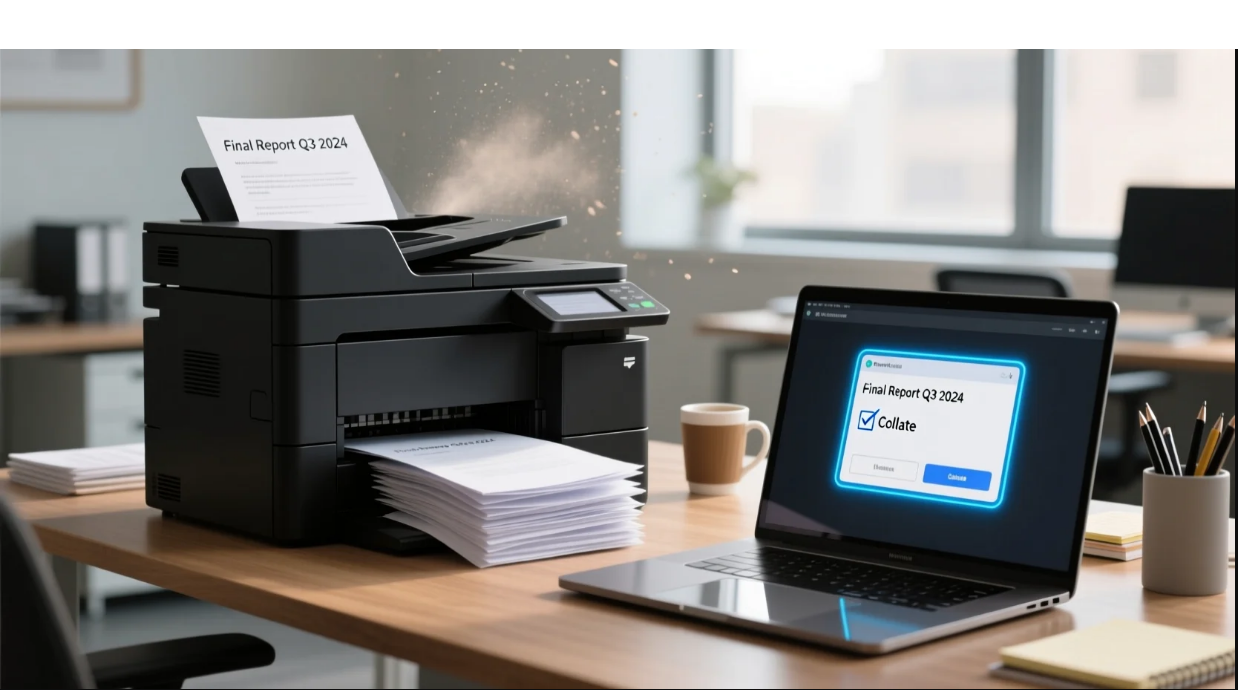Understanding printing functions is essential for anyone who frequently handles documents, whether in an office, school, or home setup. One of the most important yet often misunderstood features is the collate option. Many users ask what does collate mean when printing, especially when preparing multi-page documents. This guide explains the concept, benefits, and practical uses of collated printing in a clear and professional manner.
What Does Collate Mean in Printing?
When you choose the option collate in a printing job, it means the printer will arrange multi-page documents in the correct order and group them into complete sets. For example, if you are printing a 5-page document multiple times, selecting collate ensures the printer outputs the pages as 1–2–3–4–5, then repeats the entire set again. Without collate, the printer would print all copies of page 1 first, then all copies of page 2, and so on.
By knowing what does collate mean when printing, users can print organized documents, saving significant time during sorting and binding.
Also, explore conroe isd sso – A Complete Guide for Students, Parents, and Teachers
Why Collated Printing Matters
Collation is extremely useful for creating organized document sets, especially in professional environments. It ensures accuracy, reduces manual sorting, and enhances productivity. Whether you are preparing meeting handouts, classroom materials, or project reports, collated printing ensures consistency across all copies.
Key Benefits of Using Collate
Streamlines Document Assembly
When printing multiple sets of multi-page files, the collate option eliminates the tedious task of sorting pages manually. This is especially beneficial when handling large volumes of documents.
Enhances Professional Presentation
Collated documents maintain clean structure and order, which is crucial for business proposals, manuals, contracts, and educational materials. A well-collated document improves readability and professionalism.
Reduces Errors
Manually organizing pages often leads to mistakes such as missing, repeated, or misplaced pages. Using the collate feature ensures each document set is printed accurately, reducing the risk of errors.
When Should You Use Collated Printing?
Ideal for Reports and Presentations
Any multi-page document shared with multiple readers should be printed in collated format. This helps distribute neat and complete sets without additional work.
Useful in Educational Settings
Teachers, trainers, and students frequently print booklets, assignments, and notes. Collated printing ensures each student receives a complete and properly ordered packet.
Efficient for Business Documentation
Workplaces benefit greatly from collated prints when producing training manuals, policy handbooks, and client proposals. It ensures consistent and dependable document arrangement.
How to Enable Collate on Printers
Most modern printers include a simple collate button in their print settings. Typically, you can enable it by:
- Opening the document you want to print
- Selecting the print menu
- Choosing the number of copies
- Checking the collate option
- Proceeding with the print job
Some advanced printers also allow automatic collation for stapled or bound copies.
Frequently Asked Questions
- What does collating do on a printer?
It arranges multi-page documents into complete, ordered sets, ensuring each printed copy is in proper sequence. - Should I use collate for single-page documents?
No, collate is only useful for documents with more than one page. - Does collating slow down printing speed?
It may take slightly longer on older printers, but modern printers handle collation efficiently. - Is collate the same as double-sided printing?
No, double-sided printing refers to printing on both sides of the paper, while collate refers to arranging pages in order. - Can collated printing be used for stapled sets?
Yes, many printers automatically staple collated sets for convenient distribution.
Conclusion
In conclusion, understanding what does collate mean when printing is essential for producing structured, professional, and error-free document sets. Using the collate feature ensures that multi-page files are printed in correct order, improves efficiency, reduces manual sorting, and enhances presentation quality. Whether at home, school, or the office, enabling this function streamlines the printing process and ensures every copy is organized and ready for use.

Best Tips and Tricks for Bitcoin Investments

Top Benefits of Hiring Professional Pet Sitting Services for Your Pets

Expert Insights on Improving Productivity and Efficiency

Accelerating drug discovery through the DEL-ML-CS approach

AI in Marketing Is No Longer a Buzzword — It’s the Strategy

What Is Deep Linking and How Does It Work?

How to Build, Customize, and Tune Your Own 50cc Mini Chopper for a Unique Look and Better Performance

Real-World Breaches That Could Have Been Prevented with Attack Surface Management (ASM)









